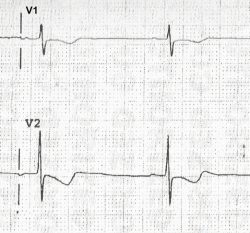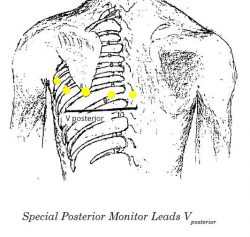There are no Leads of the standard 12-lead ECG that most accurately monitor the right ventricle (RV) or the Posterior LV. Therefore you must add special leads that do so.
It is no trite statement to say:
If you do not look for the “Posterior STEMI” or the “RV STEMI”, you will never find one.
This search involves the placement of extra leads as listed below:
|
Infarcted Area |
Special Leads |
|
RV STEMI |
V4R |
|
Posterior STEMI |
V7, V8, V9 |
PEARL:
The Acute Inferior STEMI is frequently associated with the RV STEMI and the Posterior STEMI. You will be looking for ST-segment elevation concave down in the special leads V4R, V7, V8, V9.
POSTERIOR INFARCTION
The posterior aspect of the heart will of course be subject to ischemia and infarction (acute and old) as is any other area of the heart. The status of the posterior aspect is determined by analyzing the lead(s) that “looks at” the posterior aspect of the heart. As has been stated earlier, no lead of the standard 12-lead looks directly at the posterior aspect of the heart. We must therefore rely on indirect measurements and consequently the information is of limited value.
As in the case of the right ventricular infarction, the posterior infarction is frequently associated with the Acute Inferior Infarction. The clinical meaning is simply that in the setting of an acute inferior MI, you should “think” acute posterior infarction and proceed to look for it.
You will certainly agree that the monitor leads V1 and V2 indirectly view the posterior aspect of the heart. It should be no surprise to suggest that we look for ST-depression in leads V1 and V2 (instead of the ST-elevations) as an indicator of acute infarction. Figure D-1.
This transformation of ST-depressions to ST-elevations can be appreciated by holding a mirror to the tracing as shown in Figure D-2. It is also important to realize that if the posterior aspect is injured, its voltage contribution will be lowered. Therefore from the vantage point of the anterior chest, the R-wave will heighten (since the anterior depolarization vector is opposed by the posterior depolarization vector). It then seems logical to predict a “larger than usual” R-wave in leads V1 and V2 in the case of the acute posterior infarction.
FIGURE D-1 ST-Depression in Leads V1 and V2
A direct monitor of the posterior aspect is reflected in lead Vposterior as shown in Figure D-3 by placing special electrodes on the patient’s back.
FIGURE D-2 Mirror Image Suggesting Diagnosis of Acute Posterior MI
FIGURE D-3. Special Posterior Monitor Leads Vposterior
The standard 12-lead ECG does not contain leads Vposterior but the leads could certainly be placed on the patient. If we are looking for evidence of an acute posterior MI or ischemia, then we as per usual look for ST-elevations and/or T-wave inversions in leads Vposterior.
RIGHT VENTRICULAR INFARCT
In order to monitor the right ventricle, one must place special leads on the chest: The right precordial leads V1R, V2R, V3R, V4R, V5R, V6R. This is shown in Figure D-4 below
Figure D-4. Placement of Right Precordial Leads
If one looks at the right precordial leads of the normal heart (non-acute MI) you will note a finding similar to the tracing attached. (Tracing D-1).
ACUTE POSTERIOR MI (THE HIDDEN-PICTURE STEMI)
Returning to the ACS patient I will pose the question: What changes would you expect to see on the 12-Lead ECG in the posterior STEMI?
ANSWER:
I would expect to see STE in those leads that “look at” the posterior aspect of the heart. But alas, NONE of the leads of the standard 12-Lead directly monitor the posterior aspect of the heart; however we can place special electrodes on the chest that do. Specifically the leads V7, V8, V9 are monitors of the posterior aspect of the heart. We know that from our previous discussion that if the cardiogram demonstrates STD in V1, that the reciprocal leads V7, V8, V9 will demonstrate STE. We therefore conclude that the POSTERIOR STEMI is presesnt if Leads V7, V8, V9 show STE.
Please look at the artist’s rendering in Illustration 12 of the vectors especially V7, V8, V9, V1, V2, V3 with their associated ST Elevation or ST Depression respectively.
→
Illustration 12. Vectors Related to Posterior STEMI.
Please note that I have included a QRS-ST-T complex associated with each triad V1, V2, V3 and V7, V8, V9 –
more particularly I have labeled 3 points on each complex: point 1, point 2 and point 3. After studying these three points, the following is clearly true: point 1 associated with V1, V2, V3 shows a positive deflection, point 1 associated with V7, V8, V9 shows a negative deflection.
Now look at point 2. The following is clearly true: point 2 associated with Leads V1, V2, V3 shows a negative deflection point 2 associated with Leads V7, V8, V9 shows a positive deflection.
Now look at point 3. The following is clearly true: point 3 associated with Leads V1, V2, V3 shows ST depression point 3 associated with Leads V7, V8, V9 shows ST elevation.
PEARL
The following is a true statement: In the setting of the acute Inferior STEMI, you sometimes will also find the acute Posterior STEMI and the acute Right Ventricle STEMI.





